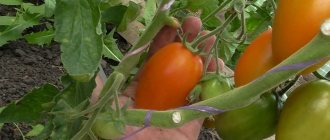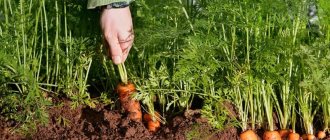Description of tomato Goose egg
The variety is classified as an indeterminate type: under favorable conditions it is capable of growing up to 2 m. The height of tomatoes is affected by climate and planting location: in warm countries or greenhouses the plant is more powerful than specimens cultivated in open ground.
According to the description and photo, Goose Egg tomatoes have a strong stem and dense foliage. Thanks to the large number of shoots, the bush looks spreading. The inflorescence is simple.
Important! Tomato growth is controlled through timely formation, staking and pinching.
Description of fruits
The goose egg tomato variety got its name due to the appearance of the fruit: they are oval in shape. There is slight ribbing in the stalk area. In addition to their presentation, tomatoes are distinguished by good transportability and shelf life (they can retain their taste and presentation for 45 days).
Characteristics of Goose Egg tomatoes:
- weight up to 300 g;
- the skin is dense and changes from green to dark pink and red as it ripens;
- crack resistance;
- ability to ripen at room temperature after removal from the brush.
Reviews about the taste of the Goose Egg tomato variety confirm that the fruits have fleshy pulp, practically without seeds and excess liquid. Tomatoes have a delicate aroma, sweetish taste with a hint of sourness.
Reviews
Lyudmila:
I grew Goose Egg in open ground. The tomatoes are very large, they are not suitable for canning in their entirety, they do not fit into the jar. I tried salting it in slices, they completely retained their shape and didn’t fall apart.
Advice from gardeners: how to prune fuchsia for winter and autumn. Features of the procedure and further care
Marina:
I planted it for the first time, almost all the seeds sprouted and grew in open ground. Not capricious, with minimal care the harvest turned out great.
Natalia:
I read how this variety was praised and planted it. The reviews did not deceive me; the variety is indeed very beautiful and productive. The fruits are large and strong, only pulp, no water. It’s just that the taste is inexpressive, but it’s quite suitable for processing.
Ilya:
The Goose Egg variety was grown in a greenhouse. I was pleased with the yield. The tomatoes are meaty and juicy. The most delicious were the overripe fruits.
Characteristics of the variety
The variety is grown in the Southern and Middle latitudes. In northern climates, cultivation of the Goose Egg tomato is possible in greenhouse conditions.
Productivity and fruiting
The variety is mid-early: the first ripe tomatoes appear 100 days from the moment the seeds are sown in the ground.
Gardeners note the stability of fruiting: a good harvest of the Goose Egg variety, subject to the rules of agricultural technology, is ensured every year. Tomatoes ripen at the same time; up to 8 kg of tomatoes are harvested from 1 m2.
The yield of the Goose Egg tomato is affected not only by climate, but also by soil fertility and compliance with the rules of agricultural technology.
Important! If you collect unripe tomatoes, they will be more shelf-stable than overripe fruits, so if long-term transportation is necessary, this feature should be taken into account.
Area of application of fruits
According to photos and reviews, Goose Egg tomatoes are often used to prepare fresh salads and culinary dishes. Thanks to their juicy pulp and pleasant taste, they make good tomato juice.
The variety can also be used on an industrial scale: the production of tomato paste and other products containing tomatoes. Pleasant appearance and keeping quality contribute to the active sale of fresh fruits.
Resistance to diseases and pests
The Goose Egg variety is resistant to late blight, but to prevent other diseases, it is necessary to follow the rules of agricultural technology and timely treat plants with drugs.
It is recommended to beware of diseases such as mosaic: affected plants cannot be cured, so they are removed from the garden bed. The disease is characterized by the appearance of spots on tomatoes and spotting of leaf blades.
Bacterial wilt and shoot necrosis cannot be treated, so preventive measures are mandatory.
Advantages and disadvantages of the variety
When choosing tomatoes, gardeners focus on the main positive and negative aspects.
Advantages of Goose Egg tomatoes:
- high productivity;
- pleasant taste;
- keeping quality;
- preservation of appearance and taste characteristics during transportation.
Among the disadvantages of the variety is the need to use supporting structures and carry out preventive measures against diseases.
Growing rules
The initial stage of cultivating a Goose Egg tomato is the selection of good seed material. It is recommended to purchase raw materials from trusted manufacturers, monitor expiration date and appearance.
Planting seedlings
Seed preparation involves selecting whole and healthy samples, treating them with a solution of potassium permanganate and stimulants.
Important! Some manufacturers independently disinfect the seed, so it is colored pinkish.
In this case, re-processing it at home is not required.
It is possible to check the germination of seeds by placing them in a glass of water: the floating samples are removed, and those remaining at the bottom are used for sowing.
Separate soil preparation is required: fertile soil is mixed with turf or purchased ready-made in gardening stores. The soil must be disinfected: poured with a solution of potassium permanganate or calcined in an oven.
Sowing can be done either in separate containers, peat pots or tablets, or in large containers (plates, boxes, disposable dishes).
Sowing is carried out 60-65 days before transferring to the ground: the container is covered with earth and the seeds are placed there, covered with film or earth on top. Seedlings must be kept in a warm, draft-free room.
Caring for Goose Egg tomatoes involves timely watering and providing access to sunlight. When 2 true leaves appear, a pick is made: the tomatoes are divided into separate pots.
2 weeks before transferring them to open ground, it is necessary to begin hardening the plants: the seedlings are taken outside, gradually increasing the residence time from a few minutes to 24 hours.
Transfer
The soil under the garden bed is dug up and fertilizers are applied. This procedure is carried out 2 weeks before planting. Holes are prepared in the formed bed: there should be no more than 3 bushes per 1 m2.
It is necessary to transfer the plant into the soil along with a lump of earth so as not to damage the roots. The top of the tomato is sprinkled with earth and watered generously with warm water.
It is recommended to immediately install support structures: they are constructed from wooden stakes, iron hoops or trellises. They are designed not only to support the stem, but also to prevent it from bending to the ground under the weight of the tomatoes.
Important! When installing such structures, it is important not to damage the root system.
The stem must be tied so that it does not bend at an unnatural angle or be injured by the support.
Aftercare
When planting the Goose Egg tomato variety in a greenhouse, the bush is planted immediately: up to 2 shoots are left on the stem. The procedure involves removing the side shoots. The pinching is repeated as the tomato grows.
In total, you need to leave 4-5 trusses on the stem and pinch the tops in a timely manner; this will prevent excessive growth of the tomato, and the plant will direct all its strength to fruiting.
When forming large clusters, they are additionally tied, making sure that the stem does not bend or get injured.
Watering is carried out as the soil dries out: in hot periods the soil is moistened more often; in unfavorable conditions, the tomatoes are additionally covered with protective structures.
The variety is not demanding on fertilizing, so fertilizers are applied 1-2 times a month as desired. It is important to avoid getting moisture on the fruits and leaves and monitor the condition of the soil, so the lower leaves are trimmed to ensure air ventilation.
Transfer
- Before planting in the ground, the seedlings need to be hardened off: they are taken outside every day for a week.
- The soil in the garden bed is watered with a solution of manganese and loosened.
- Since the indeterminate variety requires tying, a trellis is immediately installed.
- Plants are planted at a distance of 50 cm from each other and watered with warm water at the root.
Bushes are formed into 1-2 stems, removing side shoots and pinching out the growing point. Shoots weighed down with fruits also need to be tied up. Watering is done once every two weeks in spring and once a week in summer.
Use warm water, water at the root or drip. The procedure can be combined with fertilizing using a solution of mineral or organic fertilizers.
After this, the soil is loosened, facilitating air access to the root system. Fertilizing is carried out once every 14 days, alternating mineral complexes and organic matter.
During flowering and fruiting, additional potassium fertilizing can be done. To control humidity levels and prevent diseases, the greenhouse is regularly ventilated.
Pest and disease control
The main preventive measure against any disease is compliance with the rules of agricultural technology: moderate watering, frequent loosening of the soil and monitoring the condition of the tomatoes.
When the first signs of the disease appear, treatment of Goose Egg tomatoes is carried out immediately. If the main stem or roots are damaged, it is recommended to remove the tomato from the garden, and treat the remaining bushes with antifungal and antibacterial agents.
In case of whitefly attacks, Goose Egg tomatoes are sprayed with Fitoverm or Aktara, the drugs destroy both caterpillars and adults. To prevent the pest from reproducing, the lower leaves of the crop are sprayed again after 7 days.
In June and July, the risk of aphid attack increases, so to destroy it, Goose Egg tomatoes are treated with a solution of Trichlorometaphos or Karbofos. Be sure to apply the drug to the bottom of the leaf. Among folk remedies, the fight against aphids using a soap-ash solution and wormwood infusion is common.
Important! Any drug is used in accordance with the instructions, a mask and glasses are put on the face, and rubber gloves are put on the hands.
Spraying of the product is carried out from the leeward side.
Diseases
The variety is resistant to various diseases
Adviсe
- When choosing a site for planting, observe crop rotation: tomatoes cannot be planted in place of nightshade crops, or next to potatoes;
- Weed the bed regularly and loosen the soil;
- Water the seedlings with manganese and ash solutions;
- Wash aphids off the leaves with soapy water and make sure there are no anthills nearby;
- If you notice blossom end rot, spray the plants with calcium nitrate;
- For gray rot, apply foliar feeding with copper sulfate.
Goose Egg, bred in Siberian conditions, is therefore generally quite resistant to many types of diseases (for example, late blight) common among other tomatoes. But in order to avoid infections, it is better to apply some measures to prevent diseases:
- Before planting in a greenhouse or soil, remove the top layer of soil to disinfect the soil from possible fungal spores.
- Tomatoes need to be treated with preparations containing copper or sulfur.
- Seedlings and bushes can be treated with fungicides and garlic solution. This treatment is carried out three times - 20 days after planting in the ground, the second time - after 40 days of planting, and during the flowering period of the brushes.
Whatever the resistance of the variety to diseases and infections, by doing all these simple manipulations, you can protect your plot and crop from infection.
Among the promising varieties, it is worth highlighting the interesting and unusual Goose Egg tomato. Tomatoes got their name from their unusual shape. It really does look a lot like a large egg.
In order to get a good harvest and avoid unnecessary hassle, you should study the characteristics and description of the Goose Egg tomato variety.











